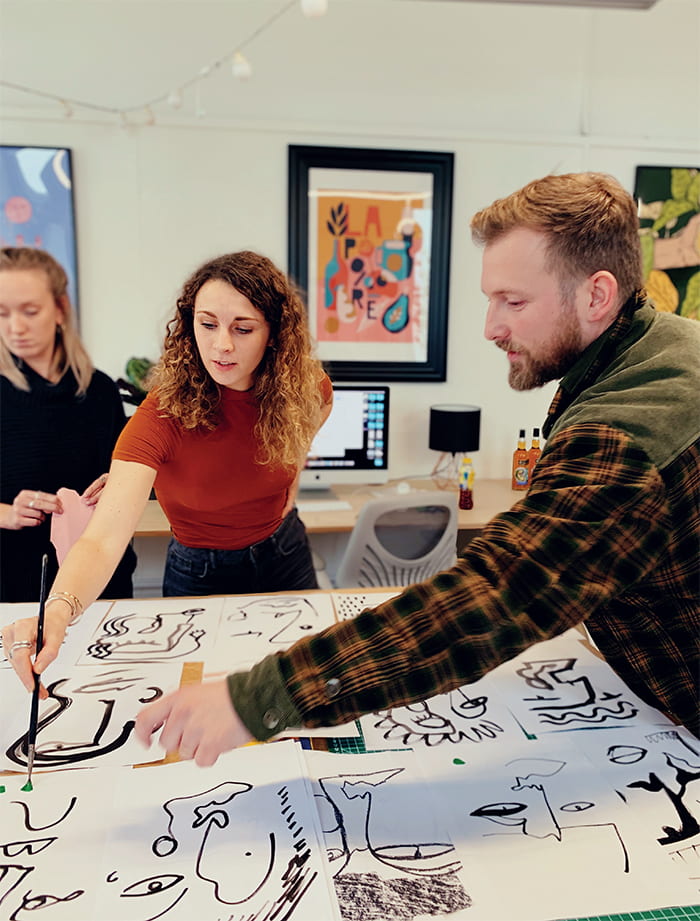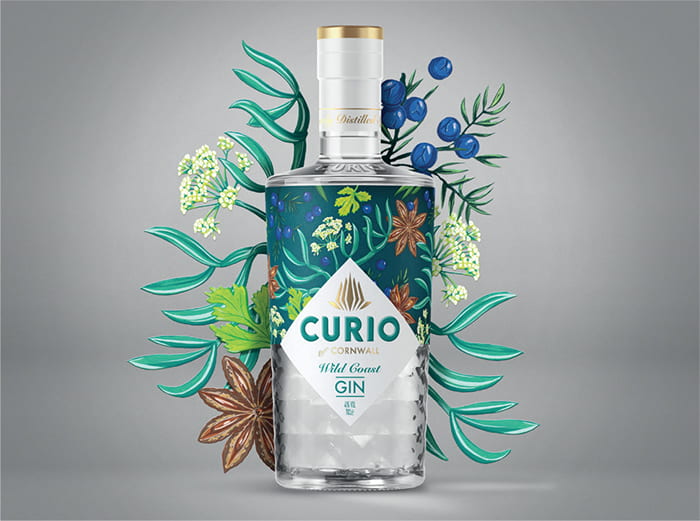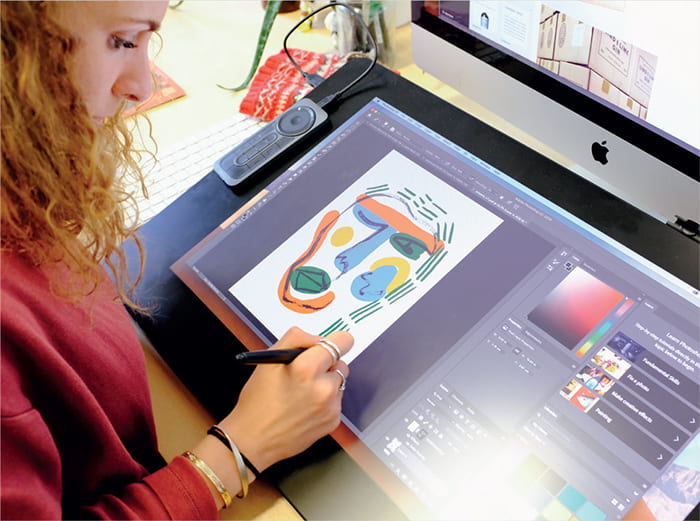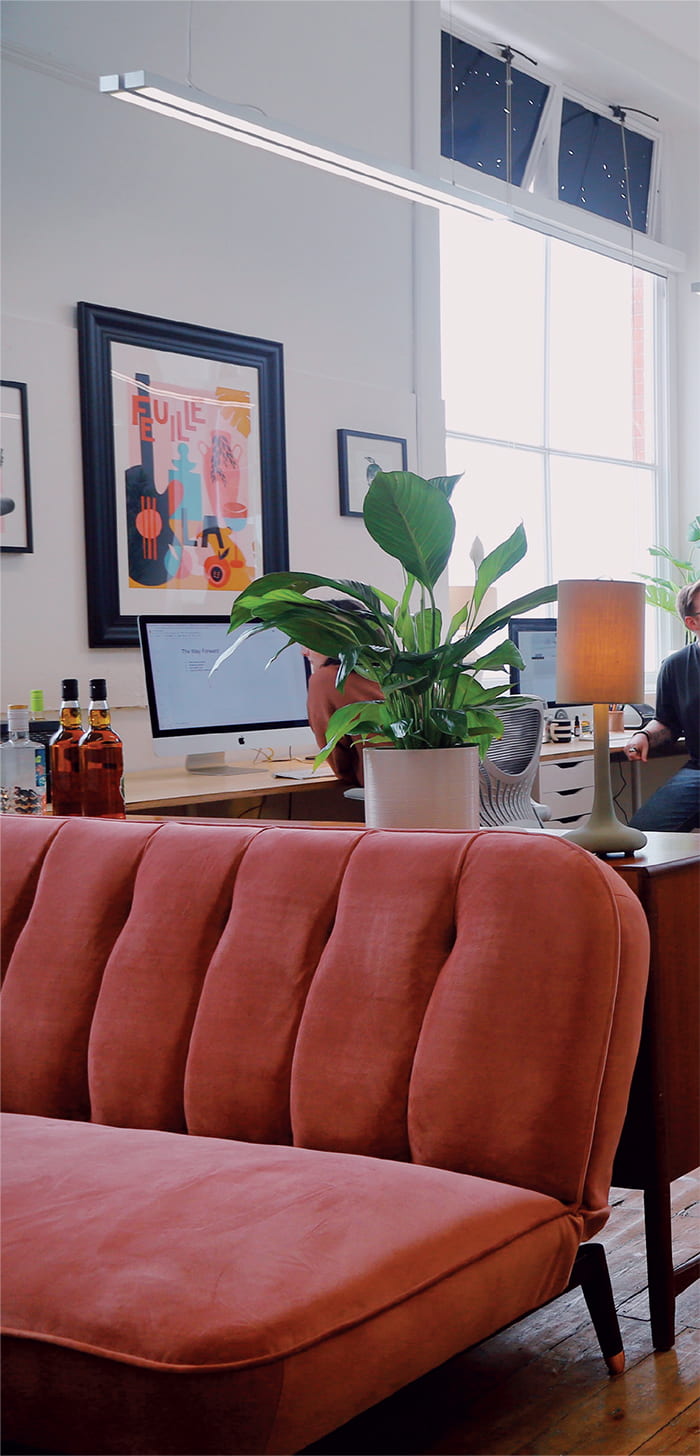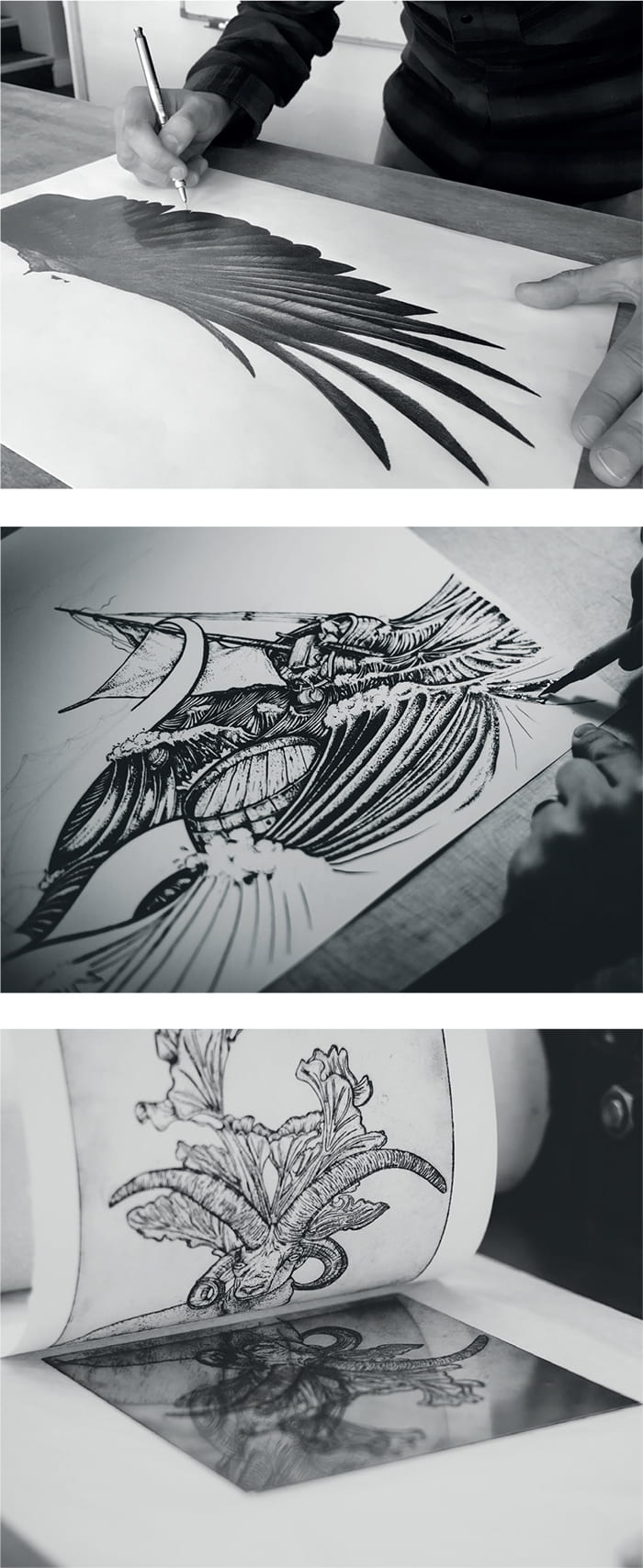ALUMNI: PACKAGING/DESIGN
JOHNNY PATON
We talk to Johnny about his journey from graduation to becoming the Creative Director of Kingdom & Sparrow, a highly successful design studio with an ever-expanding reputation for innovation and quality.
Q: Can you tell us about your journey from graduation to where you are today? What inspired you to create your own design business? How did you go about selecting your team? What do you consider to be the key qualities that have led to Kingdom & Sparrow’s success?
After graduating from the Illustration course I knew that I had a lot of the technical and professional skills needed for a commercial career, which really enthused me. I spent a few years developing my practice and working on commissions, while figuring out exactly what I wanted to do with my career and which path to take. Starting up a design business with a friend was a natural progression, although it took a few years before having the confidence, means and impetuous to do so. Neither of us had any formal experience in the design industry, but our passion for brands and products (particularly food and drink), carried us forward. At the time there was a real artisan food movement happening and Cornwall was at the forefront of this ‘foodie’ revolution, so it was a relevant and opportunist move. My Illustration skills naturally complemented this expanding world of artisan and lifestyle products. Slowly but surely we expanded our knowledge and refined our skillset through collaborating with various companies. Our journey was progressive and we learned a huge amount along the way. This development enabled us to build a successful branding agency. We’ve been incredibly lucky in that Falmouth attracts such creativity – either directly from the University or from people who are inspired by the Cornish way of life. So, through internships and job opportunities we’ve been able to build a team that shares in our creative vision.
Q: Have you worked on any particularly memorable or unusual projects?
Every project is entirely different; the sheer variety keeps it exciting! Each project feels completely new and so each is memorable in its own right. To help each business moving forward in a competitive world, we problem solve. Each client has a different need, so to cater for this we have to adapt. There is one element that is consistent across every commission – we Ponet Spirits Company, Telegram Mezcal; Curio Spirits Company, Wild Coast Gin; Concept work at Kingdom & Sparrow prioritise forging the right relationship with each client in a way that is mutually beneficial and relevant.
“One of the biggest challenges is forging the right kind of relationships with each client in a way that is going to end up with results that benefit both of us. Ultimately we have to solve problems to help other businesses move forward in a competitive world.”
Q: You often collaborate with brands to help build, improve or alter their identity. What does this process look like?
Our process is incredibly flexible and depends entirely on the client’s needs and the stage of their journey. Sometimes we’re starting from scratch and building the entire brand, visually interpreting their set of values; other times the projects are more specific and well defined. We always start by really getting to know the client and understanding their ethos – what they’re all about. Then we develop a tailor made creative strategy to make sure we’re channelling our energy and time in the right direction, both creatively and strategically. Our job is to figure out the best way to move forward, and this involves collaborating closely with our clients to make sure the brand we develop is absolutely right for them, their business and their customers.
Q: Many of your commissions are directed towards children. In particular, many of these projects aim to attract and engage the younger generation in positive behaviours such as healthy eating and exercise. How does your creative journey differ when designing for children? Do you think that the use of illustration is particularly valuable for this audience?
It’s a real pleasure to work on children’s brands. Illustration is often at the heart of these projects as it links children to a world they know and love – a world of storytelling and imagination. We aim to bring the products to life through the use of illustration, often developing characters and including interactive elements in our designs. This is really useful when trying to engage both children and parents, and helps to highlight the positive benefits that a product has to offer in an exciting way.
Q: Kingdom & Sparrow have been involved in a wide array of exciting commissions, across many different platforms – from large scale billboards to small scale beer bottles and biscuit packaging (and everything in between!). How does the context and format of each project effect your creative process – do you tailor your initial ideas to their final application or begin by thinking more openly? Do you mock up your concepts as 3D designs to aid with visualisation?
We always start by trying to forge a brand’s personality and visual identity. What we’re ultimately trying to do is create a suite of distinctive brand assets that are the core of the brand’s identity. These can then be applied to a number of different mediums and platforms so that the brand is always recognisable and consistent. Generally we aim to produce three or four alternative approaches and work with the client to select the most appropriate direction. When we’re showing our ideas to clients it’s always helpful to present 3D imagery to give them an idea of how the designs will work practically for them and to help them make an informed decision.
Q: Working in a team as part of a successful design studio clearly involves a huge amount of collaboration. Are all members of the team involved in the early ideas generation stage? Do members of the team work purely within their area of expertise, graphic design or typography for example, or is there a more interdisciplinary approach? What does your role as creative director involve?
As a team we’re very collaborative. Of course, everyone has their strengths, but we encourage a multi-disciplinary approach and we’re not afraid to help people learn new skills or be pushed outside their comfort zone. We find that a collaborative approach within the studio helps people share these skills, which in turn creates stronger and more considered work. As creative director I help coordinate and guide our work and provide the leadership that’s required to make sure we are achieving the best results for each project. This can often mean pushing creative boundaries and challenging the client’s expectations and preconceptions.
Q: Illustration is featured prominently throughout Kingdom & Sparrow’s portfolio; is this a deliberate choice? Do you feel that your use of illustration helps to distinguish Kingdom & Sparrow from other design agencies?
As a creative director with an illustration background and education it’s come naturally to us and has been a design tool that’s at our fingertips. It also helps our designers to be creative and to think outside the traditional expectations of a graphic design team. It does help to distinguish us but it’s not a prerequisite for every branding project. Illustration is a highly valued component in our creative toolkit, and we use it whenever it’s appropriate. We think of it as an extra string to our bow.
Q: Your projects are extremely diverse in terms of their visual language; you demonstrate an incredible range of media, technique and process in order to achieve a dynamic portfolio. Are there any key qualities that are consistent throughout all of your commissions?
Being flexible in style and ability is key to providing tailored work, especially with clients and brands that are all very different. It’s helped us grow as a business because potential clients want to be confident that we can deliver a unique approach to their brand without imparting a ‘house style’ or developing a brand that feels like everything else on the shelf. We try to innovate as much as possible, so we don’t have a consistent style or method but what remains consistent is the thought, the consideration and the problem solving that is a huge part of our process.
Q: From traditional painting to slick vectors, from printmaking to procreate, how do you keep your skills sharp across a broad range of media?
We’re not afraid to experiment and if we see something creative in the world that we’re intrigued by and don’t yet use, we’re always open to discovering how we can use that in-house. As a team of creatives we’re naturally curious and drawn to the work of other artists and designers.
Q: Increasingly illustrators are being employed to work in-house at design agencies. What skills do you look for in the illustrators you employ and commission? What skills would you say are more important: ideas generation and visual problem-solving or aesthetic visual skills?
I think ideas generation and visual problem-solving skills go hand in hand with aesthetic visual skills. An idea and concept are extremely important but being able to execute it in a way that communicates the idea successfully is also paramount. An illustrator who works with us in-house needs to be more adaptable in style and creative output than a freelance illustrator who’s forging their own path. They have to be able to meet the individual challenges of each project they work on. When we commission freelance illustrators, we recognise them as masters of their craft, with unique ways of thinking and a distinctive visual language, which we will draw upon with the knowledge and confidence that their style is consistent. With freelance illustrators we generally know what to expect and this makes it easier to commission the right person for a particular project.
“I think ideas generation and visual problem-solving skills go hand in hand with aesthetic visual skills.”
Q: What skills did you develop whilst studying on the BA Illustration course at Falmouth, and how did the course prepare you for working within your role as Creative Director? Did you gain any interdisciplinary skills that you feel are particularly useful for working within a design team?
The course trained me in the traditional skills of image making and introduced a way of thinking that’s appropriate for commercial design. From life drawing to colour theory, and from conceptual thinking to professional practice, all aspects of the course were extremely valuable and emerge every day in the work we produce.

